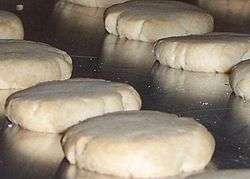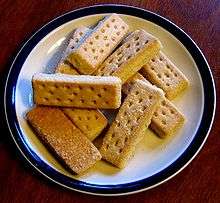Shortbread
Shortbread is a traditional Scottish biscuit usually made from one part white sugar, two parts butter, and three parts plain wheat flour. Other ingredients like ground rice or cornflour are sometimes added to alter the texture. Modern recipes also often deviate from the original by splitting the sugar into equal parts granulated and icing sugar and many add a portion of salt.[2] Unlike many other cookies and baked goods, shortbread does not contain any leavening, such as baking powder or baking soda. Shortbread is widely associated with Christmas and Hogmanay festivities in Scotland, and some Scottish brands are exported around the world.
 Fully cooked shortbread rounds on a baking sheet | |
| Type | biscuit |
|---|---|
| Place of origin | Scotland |
| Main ingredients | Flour, butter, white sugar |
| Other information | glycaemic load 40 (100 g)[1] |
Name
Shortbread is so named because of its crumbly texture (from an old meaning of the word "short," as opposed to "long," or stretchy). The cause of this texture is its high fat content, provided by the butter. The short or crumbly texture is a result of the fat inhibiting the formation of long protein (gluten) strands. The related word "shortening" refers to any fat that may be added to produce a "short" (crumbly) texture.[3] Alternatively, the name may be derived from 'shorts', the bran and coarse part of meal.[4]
Shortbread is different from shortcake, though they are similar: shortcake can be made using vegetable fat instead of butter and usually has a chemical leavening agent such as baking powder, which gives it a different texture. Shortbread biscuits are often associated with normal egg-based biscuits, but they hold their shape under pressure, making them ideal for packed meals.
Shapes

Shortbread is traditionally formed into one of three shapes: one large circle, which is divided into segments as soon as it is taken out of the oven (petticoat tails, which may have been named from the French petits cotés, a pointed biscuit eaten with wine, or petites gastelles, the old French for little cakes. This term may also reference a petticoat's bottom[5]); individual round biscuits (shortbread rounds); or a thick (¾" or 2 cm) oblong slab cut into fingers.
The stiff dough retains its shape well during cooking. The biscuits are often patterned before cooking, usually with the tines of a fork or with a springerle-type mold. Shortbread is sometimes shaped into hearts and other shapes for special occasions.
Varieties
Cultural associations
Shortbread is generally associated with and originated in Scotland, but due to its popularity it is also made in the remainder of the United Kingdom, and similar biscuits are also made in Denmark, Ireland and Sweden. The Scottish version is the best-known, and is widely exported.
Shortbread was chosen as the United Kingdom's representative for Café Europe during the 2006 Austrian presidency of the European Union.
Scottish chef John Quigley, of Glasgow's Red Onion, describes shortbread as "the jewel in the crown" of Scottish baking.[6]
An early variety of shortbread, using ginger, was reportedly eaten during sittings of the Parliament of Scotland, and therefore the variety was sometimes called "Parliament cake" or "Parlies" into the 19th century.[7][8] The biscuits are likely to have been made and sold by the shop "Luckie Fykie" in Waverley, Edinburgh.[9]
History
Shortbread originated in Scotland, with the first printed recipe, in 1736, from a Scotswoman named Mrs McLintock.[10]
Shortbread resulted from medieval biscuit bread, which was a twice-baked, enriched bread roll dusted with sugar and spices and hardened into a hard, dry, sweetened biscuit called a rusk.[11] Eventually, yeast from the original rusk recipe was replaced by butter, which was becoming more of a staple in Britain and Ireland.
Although shortbread was prepared during much of the 12th century, the refinement of shortbread is credited to Mary, Queen of Scots in the 16th century.[12] This type of shortbread was baked, cut into triangular wedges, and flavored with caraway seeds.
Shortbread was expensive and reserved as a luxury for special occasions such as Christmas, Hogmanay (Scottish New Year’s Eve), and weddings. In Shetland, it is traditional to break a decorated shortbread cake over the head of a new bride on the entrance of her new house.[13][14]
See also
- Butter cookie
- Millionaire's shortbread, shortbread topped with caramel and chocolate
- Shortcake, a soft cake with a similar name
- Nankhatai
- List of shortbread biscuits and cookies
References
- "Glycemic index for 60+ foods". Health.harvard.edu. 2018-03-14. Retrieved 2018-04-16.
- "Of edible substances: Friable, easily crumbled." Oxford English Dictionary.
- "Online Etymology Dictionary". Retrieved 2007-01-25.
- Chambers English Dictionary - 7th edition
- Jamieson, John (1825). A etymological dictionary of the Scottish language. University Press for W. & C. Tait. Retrieved 2009-05-29.
- "Chef John Quigley discusses and bakes Scottish Shortbread". Scotlandontv.tv. 2006-10-24. Retrieved 2009-05-29.
- Jamieson, John (1841). An etymological dictionary of the Scottish language (2nd ed.). Edinburgh: Andrew Shortrede. p. 191. Retrieved 10 May 2018.
- The Oxford Companion to Food, Alan Davidson. Oxford University Press, 2014
- "Traditional Scottish Recipes - "Parlies"". Rampantscotland.com. Retrieved 2018-04-16.
- Hyslop, Leah. "Potted histories: shortbread". The Telegraph (6 October 2013). Retrieved 18 February 2014.
- "The History of Shortbread Cookies". The Nibble. Retrieved 10 February 2015.
- "History of Shortbread". English Tea Store. Retrieved 10 February 2015.
- Historic UK - heritage of Britain accommodation guide. "Scottish Shortbread". Historic-uk.com. Retrieved 2010-11-24.
- "History of Shortbread & Shortbread Recipes". Englishteastore.com. Retrieved 2010-11-24.